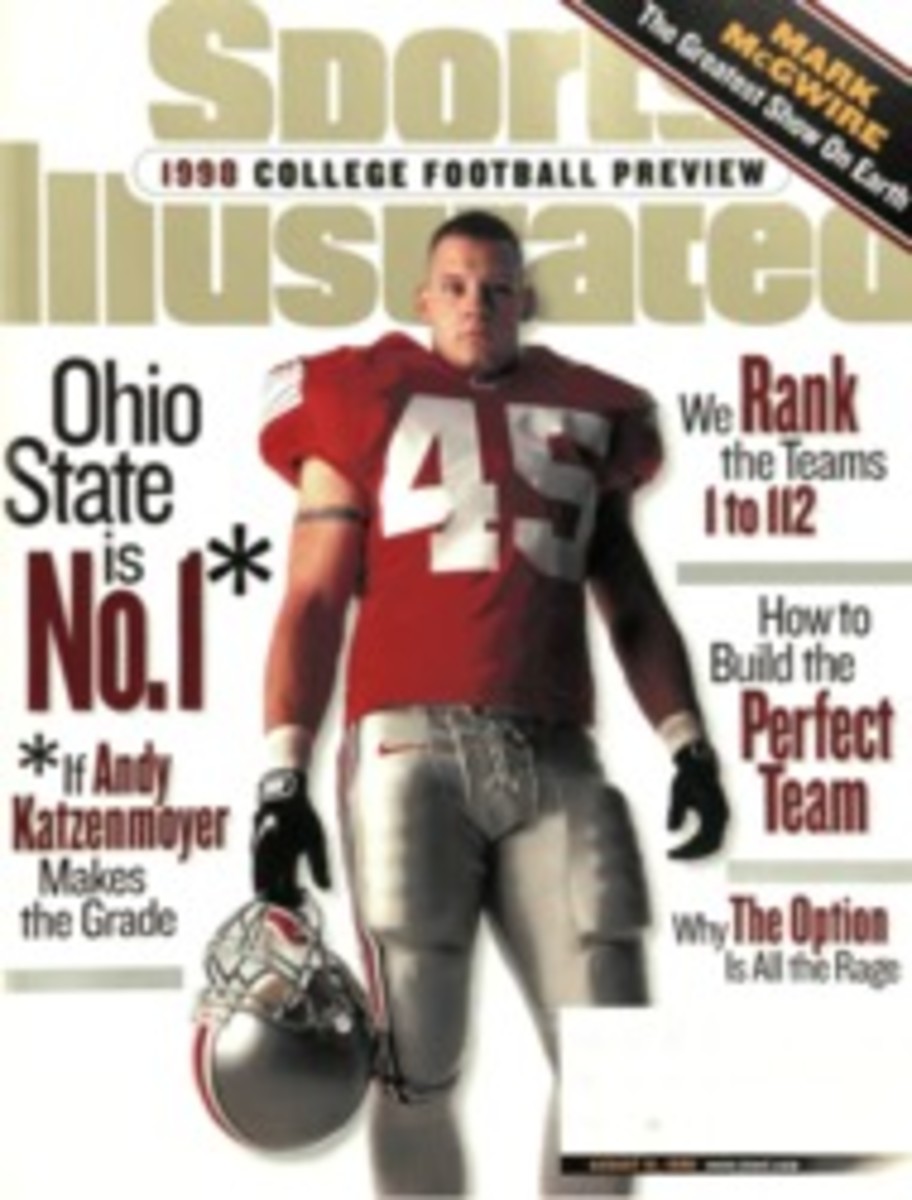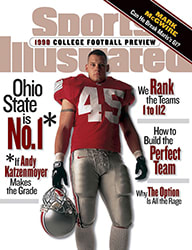
Inside The NFL
THE MAN IN CHARGE
With his job on the line, Jets quarterback Glenn Foley showed
he's ready to be the starter
When he learned he would not start the second game of the
exhibition season, Glenn Foley, who was supposed to be the Jets'
first-stringer, did what most of us do when we've hit rock
bottom: He called Mom. Boy, did she set him straight. "Glenn
started to talk about this and that and how Bill Parcells was
treating him, and I just cut him off," says Sue Foley. "I said,
'Hey, Glenn, not everybody has to love his boss. But we all
still have to do our job.'" In the case of a quarterback working
for Parcells, truer words may have never been spoken.
Foley, the carrot-topped former Boston College passer, entered
training camp as the No. 1 quarterback after Parcells had cut
high-priced and often ineffective Neil O'Donnell in the
off-season. The move was based largely on Foley's scrappy
performances while subbing for O'Donnell in 1997, particularly a
24-19 comeback victory over the Patriots in Week 8, a game in
which Foley completed 14 straight passes at one point and
engineered three second-half scoring drives.
But early in camp Parcells didn't see the same kind of fire in
Foley that he had witnessed last season. So Parcells, who was
worried that a subpar passing attack would force him to overuse
running back Curtis Martin, started free-agent pickup Vinny
Testaverde against the Ravens on Aug. 15. (For good measure
Parcells let Foley find out through the media.) After both
quarterbacks struggled in a 33-0 loss to Baltimore, Parcells
announced that Foley was his starter again.
Through it all, Foley tried to be as calm as Parcells was
calculating. "Hey, I knew way before it happened that something
like this was coming," says Foley, a seventh-round draft pick by
the Jets in 1994. "It's part of playing for Bill. I mean, the guy
had a quarterback controversy when he was in the Super Bowl with
the Giants. It's probably going to happen to me every year. You
fight through it. That's just the way he motivates me."
Whatever the system, it seems to have worked for Foley. A year
ago, as O'Donnell's clipboard caddie, he couldn't even get
tickets for his parents to the annual preseason game against the
Giants. So Sue and Ed Foley, who is also a former BC
quarterback, drove up the New Jersey Turnpike from Cherry Hill,
sat in their car in the Giants Stadium parking lot and listened
to the game on the radio. But last Thursday night, with Sue and
Ed in the stands for this year's rematch against the Giants,
Foley completed his first nine passes and finished 14 of 22 for
192 yards and one TD in a little more than two quarters of work.
The 27-23 win earned Foley a hug from Mom and praise from
Parcells, who said, "This is what I hoped would happen. He's got
work to do, but that was progress."
Most important, Foley attacked the defense and played with
passion. When Giants star cornerback Jason Sehorn went down with
a season-ending knee injury on the opening kickoff, Foley picked
apart every sub the Giants used in Sehorn's spot. Foley also
audibled several times to plays that yielded big gains.
After throwing an interception that safety Percy Ellsworth
returned 42 yards for a touchdown at the start of the second
half, Foley was afraid he might get yanked again. "With Bill you
never know what to expect," he says. Instead Foley returned on
the next series and threw a 30-yard strike to Keyshawn Johnson.
Afterward Parcells was so impressed with how Foley had responded
that as he walked past Foley's locker, he shouted, "Hey, look,
it's Dan Fouts!"
For one night, anyway.
Lions Linebackers
TRYING TO FILL BROWN'S SHOES
The first time linebacker Allen Aldridge saw a replay last
December of the collision that nearly killed Lions linebacker
Reggie Brown in Detroit's regular-season finale, he paused in
his living room in Denver and prayed for Brown, whom he had
never met. The replay showed Brown attempting to tackle the
Jets' Adrian Murrell when he collided with a New York lineman
and jammed his neck. Brown had to be resuscitated on the field
as shaken players and a national television audience looked on.
In February the Lions signed Aldridge, a free agent who played
for the Broncos the last four years, to replace Brown. "You can
still see the hurt in the guys' hearts around here," says
Aldridge. "When you lose a player like that, someone who was a
leader, it's going to affect the team for a long time. I told
the guys right away, 'You can't ever replace Reggie, because
there are no other players like him.'"
As a 6'1", 255-pound middle linebacker, Aldridge piled up 319
tackles in Denver but is probably most remembered for his
interception in the end zone that helped the Broncos defeat the
Steelers in the 1997 AFC Championship Game. Although Denver
would have liked to keep him, he signed with the Lions for two
reasons. First, he wanted to shift back to outside linebacker, a
position he played in college, and second, the Lions lavished a
four-year, $10 million deal on him.
As for Brown, he suffered a contusion of the cervical spine that
day against the Jets and underwent surgery to stabilize his
neck. According to doctors, one in five people who have such an
injury die, yet three months after he was hurt, Brown was
playing basketball. In April he walked into the Silverdome to
watch the Lions' 1997 highlight film with his teammates. "That
was an emotional time for us," says Detroit defensive
coordinator Larry Peccatiello. "It helped that Reggie made such
a great recovery. Once the guys saw him it was, like, O.K. let's
put this behind us and get back to business."
Brown, the Lions' No. 1 draft pick in 1996, was a quick, strong,
intuitive player who, in the age of the specialist, could rush
the passer, stop the run and drop into coverage with equal
effectiveness. Last season he was Detroit's second-leading
tackler, with 157. His old teammates still talk about the bullet
thrown by the Packers' Brett Favre in Week 5 that Brown plucked
out of the air and ran back for a touchdown.
While Brown has almost completely recovered--he says he
sometimes feels numbness in his extremities--he retired at 23
rather than risk a paralyzing injury and has re-enrolled at
Texas A&M in hopes of completing his economics degree. "I try
never to let myself feel down," he says. "I always try to
remember how bad it could have been. I'm beating the odds. I
could be in a wheelchair now."
"Reggie played every down as if he were shot out of a gun," says
Detroit middle linebacker Stephen Boyd. "He saved my butt a
bunch of times. The guy was huge and fast, but what I remember
most was he was so smooth at everything. How do you replace a
guy like that?"
COLOR PHOTO: JOHN IACONO JET ENGINE Foley won over Parcells with an impassioned performance against the Giants. [Glenn Foley in game]
COLOR PHOTO: PAUL HANNY/GAMMA LIAISON [Otzi the Iceman]
COLOR PHOTO: DUANE BURLESON/AP [Steve DeBerg]
MR. ICEBERG AND MR. DEBERG
This summer the oldest men in two very different
fields--archaeology and football--have been on display. In April
the remains of Otzi the Iceman, the world's oldest known corpse,
were made public at a museum in Bolzano, Italy. In July the
Falcons signed quarterback Steve DeBerg, who was drafted in 1977
and last played in '93. Turns out the world's oldest remains and
the NFL's oldest player have a lot in common.
Category Otzi DeBerg
Age 45 (at death) 44
Time out of circulation 5,300 years 1,825 days
Preserved by glacier ice packs
Strong arm used for slinging arrows bullets
Injuries ribs (3302 B.C.) shoulder (1983)
Famous look-alike Neil Young Neil Young
Older than Moses Bill Cowher
Younger than Adam Mick
Rediscovered by German hikers Dan Reeves
Mountain nadir Froze to death 24 interceptions
in Otzal Alps as backup,
1981 to '83
Endorsements Pizza, ice cream None
Currently on display in a steel-framed, steel-framed,
temperature- temperature-
controlled tomb controlled dome

